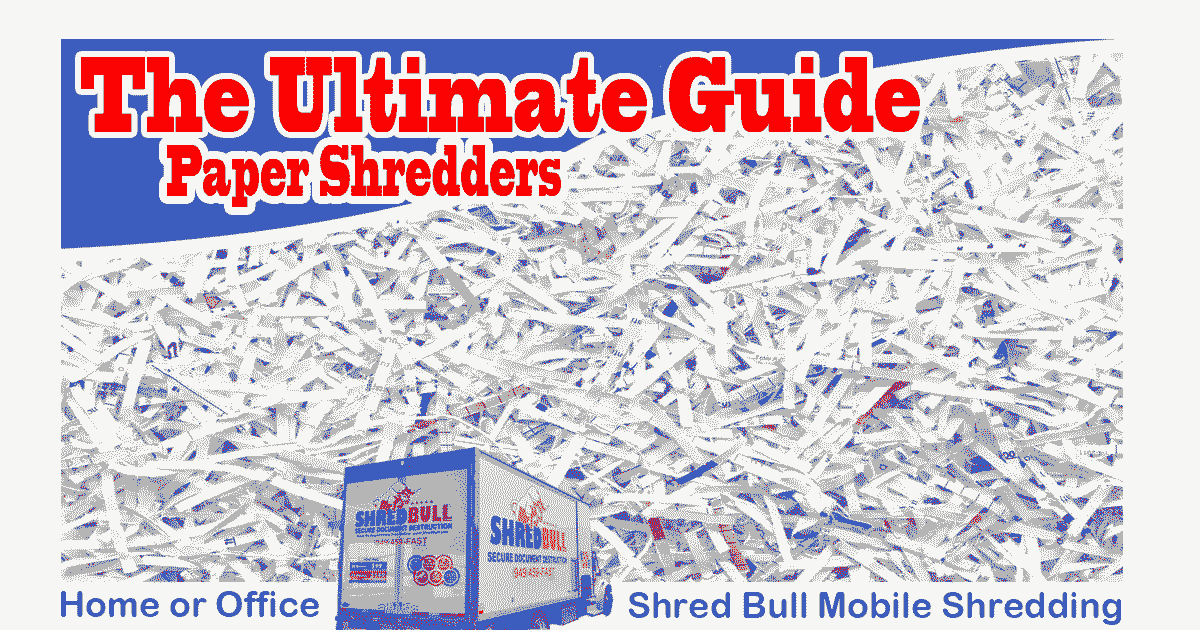The Ultimate Guide to Paper Shredders: Everything You Need to Know
Introduction
In today’s digital age, where privacy and data protection are paramount, paper shredders have become an essential tool for individuals and businesses alike. With the increasing risk of identity theft and information breaches, it’s crucial to securely dispose of confidential documents. A paper shredder offers a convenient and effective solution to safeguard sensitive information and maintain your privacy.
In this comprehensive guide, we will delve into the world of paper shredders, exploring their different types, features, and benefits. We’ll also provide expert tips on choosing the right paper shredder for your specific requirements and share essential maintenance practices to prolong the lifespan of your shredder. So, let’s dive in and uncover everything you need to know about paper shredders!
What is a Paper Shredder? {#what-is-a-paper-shredder}
 A paper shredder is a mechanical device designed to cut paper documents into small, unreadable pieces, ensuring the secure disposal of sensitive or confidential information. Paper shredders are commonly used in offices, homes, and businesses to protect against identity theft, fraud, and unauthorized access to sensitive data.
A paper shredder is a mechanical device designed to cut paper documents into small, unreadable pieces, ensuring the secure disposal of sensitive or confidential information. Paper shredders are commonly used in offices, homes, and businesses to protect against identity theft, fraud, and unauthorized access to sensitive data.
With the advancement of technology, paper shredders have evolved to accommodate various shredding techniques and security levels. From basic strip-cut shredders to advanced micro-cut models, paper shredders offer a range of options to cater to different shredding needs.
The Importance of Paper Shredders {#the-importance-of-paper-shredders}
Identity theft has become a prevalent concern in today’s digital landscape. Criminals often exploit discarded documents containing personal information to commit fraud or gain unauthorized access to sensitive data. To protect yourself, your business, or your clients from falling victim to identity theft, it’s crucial to incorporate proper document disposal practices.
Paper shredders play a vital role in safeguarding confidential information. By reducing documents to confetti-like particles, shredders render them virtually impossible to reconstruct. This significantly reduces the risk of identity theft and ensures the protection of personal and business data.
Moreover, paper shredders also aid in compliance with privacy laws and regulations. Many industries, such as healthcare and finance, are bound by strict guidelines regarding the disposal of confidential information. Utilizing a paper shredder helps organizations meet these compliance requirements and avoid legal consequences.
Types of Paper Shredders {#types-of-paper-shredders}
Paper shredders are available in different types, each offering varying levels of security and convenience. Understanding the different types will help you choose the most suitable paper shredder for your specific needs. Let’s explore the three primary types of paper shredders:
Strip-Cut Shredders {#strip-cut-shredders}
Strip-cut shredders are the most basic and commonly found type of paper shredders. They cut documents into long, narrow strips. While strip-cut shredders provide a basic level of security by rendering documents unreadable, the strips can still be reassembled with considerable effort.
Strip-cut shredders are suitable for disposing of non-sensitive documents, such as junk mail or non-confidential paperwork. However, they are not recommended for disposing of highly sensitive information.
Cross-Cut Shredders {#cross-cut-shredders}
Cross-cut shredders offer a higher level of security compared to strip-cut shredders. Instead of long strips, cross-cut shredders cut documents both horizontally and vertically, turning them into small, square-shaped pieces. This significantly reduces the chances of reconstructing shredded documents.
Cross-cut shredders are widely used in offices and businesses that deal with moderately sensitive information. They strike a balance between security and shredding speed, making them a popular choice for most users.
Micro-Cut Shredders {#micro-cut-shredders}
For those who require the highest level of security, micro-cut shredders are the ideal choice. These shredders use advanced technology to reduce documents into tiny, confetti-like particles. Micro-cut shredders offer the highest level of protection against unauthorized document reconstruction.
Micro-cut shredders are commonly used by government agencies, financial institutions, and organizations dealing with highly confidential information. While they provide unparalleled security, micro-cut shredders may have a slower shredding speed compared to strip-cut or cross-cut models.
Key Features to Consider {#key-features-to-consider}
When choosing a paper shredder, several key features should be considered to ensure optimal performance and functionality. Let’s explore these essential features:
Shredding Capacity {#shredding-capacity}
The shredding capacity refers to the number of sheets a paper shredder can handle at once. It’s important to consider your shredding needs and choose a shredder with an appropriate shredding capacity. Opting for a higher shredding capacity will increase efficiency and save time, especially for businesses or individuals with large volumes of documents to shred regularly.
Security Level {#security-level}
The security level indicates the size and shape of the shredded paper particles, determining the level of confidentiality and protection provided. Shredders are assigned security levels based on internationally recognized standards.
The higher the security level, the smaller and more intricate the paper particles, making it increasingly challenging to reconstruct shredded documents. Assess your data sensitivity and select a shredder with a security level that aligns with your privacy requirements.
Speed and Run Time {#speed-and-run-time}
The shredding speed and run time of a paper shredder play a crucial role in determining its efficiency. Shredders with higher shredding speeds can process more documents in a shorter time, making them ideal for businesses with heavy shredding needs.
Similarly, the run time refers to the continuous operation duration before the shredder needs to cool down. Consider your shredding requirements and opt for a shredder with an appropriate run time to ensure uninterrupted shredding sessions.
Noise Level {#noise-level}
The noise level of a paper shredder is an important consideration, particularly for office or home environments where a quieter operation is preferred. Look for shredders with noise reduction technology or quieter motor systems to minimize disturbances while shredding.
Safety Features {#safety-features}
Safety should be a top priority when using any mechanical device, including paper shredders. Look for safety features such as automatic shut-off when the shredder is overloaded or when the bin is full. Additionally, shredders with safety sensors that detect foreign objects and halt the shredding process help prevent accidents and damage to the shredder.
Choosing the Right Paper Shredder {#choosing-the-right-paper-shredder}
Selecting the right paper shredder involves considering your specific needs, security requirements, shredder features, and budget. Here are some essential tips to guide you in choosing the perfect paper shredder:
Identify Your Shredding Needs {#identify-your-shredding-needs}
Begin by assessing your shredding requirements. Consider the volume and types of documents you need to shred regularly. Determine if you need a shredder for personal use or for an entire office or business.
Consider the Security Requirements {#consider-the-security-requirements}
Evaluate the sensitivity of the information you handle and the level of security required. Depending on the nature of your documents, choose a shredder with an appropriate security level that aligns with your privacy needs.
Evaluate Shredder Features {#evaluate-shredder-features}
Review the key features mentioned earlier and determine which ones are crucial for your shredding tasks. Consider the shredding capacity, speed, run time, noise level, and safety features when comparing different shredder models.
Budget Considerations {#budget-considerations}
Set a budget for your paper shredder purchase. Paper shredders vary in price depending on their features and security levels. It’s essential to find a balance between your budget and the desired shredder specifications. Remember that investing in a higher-quality shredder may save you money in the long run by offering better durability and performance.
Paper Shredder Maintenance Tips {#paper-shredder-maintenance-tips}
Proper maintenance of your paper shredder is crucial to ensure its longevity and optimal performance. Follow these maintenance tips to keep your shredder in top condition:
Regular Cleaning {#regular-cleaning}
Clean your shredder regularly to remove paper dust, debris, and residual adhesives. Use a soft cloth or a specialized shredder cleaning sheet to wipe the shredding blades and the feed entry. Regular cleaning prevents clogs and ensures smooth operation.
Lubrication {#lubrication}
Lubricate your shredder blades periodically to minimize friction and maintain proper functioning. Consult the manufacturer’s guidelines for the recommended shredder oil or lubricant. Apply the lubricant according to the instructions provided, typically by running a few sheets of lubricated paper through the shredder.
Proper Use {#proper-use}
Follow the manufacturer’s instructions for the correct use of your paper shredder. Avoid overloading the shredder beyond its designated capacity, as this can lead to jams or damage. Remove staples, paper clips, and other metal objects before shredding to prevent blade damage.
Jam Prevention and Troubleshooting {#jam-prevention-and-troubleshooting}
To prevent paper jams, feed the documents into the shredder gradually, rather than all at once. If a jam does occur, switch the shredder to reverse mode to release the jammed paper. Most shredders have a manual release feature or a reverse switch specifically for this purpose.
Scheduled Inspections {#scheduled-inspections}
Regularly inspect your shredder for any signs of wear, loose parts, or mechanical issues. Address any problems promptly to prevent further damage. If you notice any unusual noises, vibrations, or difficulties in shredding, consult the manufacturer’s troubleshooting guide or seek professional assistance if necessary.
Benefits of Using a Paper Shredder {#benefits-of-using-a-paper-shredder}
Using a paper shredder offers numerous benefits beyond data protection. Let’s explore some of the key advantages:
Identity Theft Prevention {#identity-theft-prevention}
By shredding sensitive documents, you significantly reduce the risk of identity theft. Shredders render documents unreadable, making it nearly impossible for criminals to piece together personal information and exploit it for fraudulent activities.
Compliance with Privacy Laws {#compliance-with-privacy-laws}
Many industries are bound by privacy laws and regulations governing the secure disposal of confidential information. Utilizing a paper shredder helps organizations comply with these regulations and avoid legal consequences.
Efficient Document Disposal {#efficient-document-disposal}
Paper shredders offer a convenient and efficient way to dispose of unwanted or outdated documents. Instead of manually tearing or discarding papers, shredding allows for quick and hassle-free document disposal while maintaining data security.
Environmental Responsibility {#environmental-responsibility}
Proper document disposal through shredding also contributes to environmental responsibility. Shredded paper can be recycled more efficiently, reducing waste and promoting sustainable practices.
Common FAQs About Paper Shredders {#common-faqs-about-paper-shredders}
How does a paper shredder work? {#how-does-a-paper-shredder-work}
Paper shredders work by feeding paper documents into a slot, where rotating blades or cutting mechanisms shred the paper into small pieces. The shredded paper collects in a bin or a bag within the shredder. The specific shredding mechanism varies depending on the type of shredder, whether it’s strip-cut, cross-cut, or micro-cut.
What documents should I shred? {#what-documents-should-i-shred}
It’s recommended to shred any documents containing personal or sensitive information. This includes financial statements, bank records, medical records, tax documents, credit card statements, and any documents with social security numbers or personal identification information. It’s better to err on the side of caution and shred any document that could potentially be used for identity theft or fraud.
Can paper shredders shred credit cards? {#can-paper-shredders-shred-credit-cards}
Yes, many paper shredders are designed to shred credit cards. Credit cards contain sensitive information, and shredding them is an effective way to prevent unauthorized use or identity theft. Look for a paper shredder that explicitly mentions its ability to shred credit cards.
Are paper shredders safe to use? {#are-paper-shredders-safe-to-use}
Yes, paper shredders are generally safe to use. However, it’s important to follow the manufacturer’s instructions and exercise caution while operating a shredder. Avoid placing fingers or other objects near the shredding blades to prevent accidents or injuries. Some shredders have safety features, such as automatic shut-off when the bin is full or when the shredder is overloaded, to enhance user safety.
How often should I empty the shredder bin? {#how-often-should-i-empty-the-shredder-bin}
The frequency of emptying the shredder bin depends on the volume of shredding and the size of the bin. It’s recommended to empty the bin when it reaches about two-thirds full to prevent jams and ensure smooth operation. Regularly emptying the bin also helps maintain optimal shredder performance.
Can a paper shredder handle staples and paper clips? {#can-a-paper-shredder-handle-staples-and-paper-clips}
Many paper shredders can handle staples and paper clips. However, it’s always a good practice to remove staples and paper clips before shredding to prevent blade damage and extend the life of the shredder. Check the manufacturer’s specifications to ensure that the shredder you choose is capable of shredding documents with staples and paper clips.
Conclusion {#conclusion}
In today’s digital age, protecting sensitive information is of utmost importance. Paper shredders provide an effective and reliable solution for secure document disposal. By investing in a quality paper shredder and following proper maintenance and usage guidelines, you can safeguard yourself, your business, or your clients from the threats of identity theft and unauthorized access to confidential data.
Remember to assess your shredding needs, consider the security level required, evaluate key shredder features, and set a budget when choosing the right paper shredder. Regular cleaning, lubrication, and adherence to safety precautions will ensure the longevity and optimal performance of your shredder.
So, don’t let your sensitive information fall into the wrong hands. Take control of your data security and invest in a paper shredder today!

